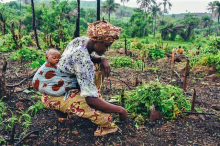 |
| Women are the backbone of rural production (Photo: CC0) |
However, gender gaps in agriculture in Africa are currently holding back progress. This is the key message of “The Regional Outlook on Gender and Agrifood Systems”, published by the UN Food and Agriculture Organisation and the African Union Commission. The report is based on a review of statistics and country gender assessments carried out in 40 countries. “We need to better recognize and harness the fundamental contribution of women to food security and nutrition,” said FAO Director-General José Graziano da Silva. “Evidence shows that when women are empowered, farms are more productive, natural resources are better managed, nutrition is improved, and livelihoods are more secure,” he added.
The Regional Outlook highlights the crucial roles of women in food production and food security. In African countries, agriculture is the most important economic sector that employs over 50% of the population, with women representing about 50% of the agricultural labour force. In some countries, women even account for up to 60% of the labour force in family farming. They are largely responsible for agricultural activities such as growing vegetables, preserving harvests and raising small ruminants such as sheep and goats. According to the study, women are also involved in household food security and nutrition through the education and care of children, the preparation of safe and nutritious meals, and the diversification of household food intake through their home garden and incomes. The authors highlight that investing in women’s education, nutrition knowledge and economic empowerment has stronger impact on food security and nutrition of children than similar investments in men, as women tend to spend a larger portion of their income on children and family welfare.
Despite women being key figures in agriculture and food security, persisting gender inequalities constrain their productivity and food security. Women’s deficits in agricultural productivity range between 20 and 30% in Sub-Saharan Africa. Closing productivity gaps could increase food production and consumption by up to 10% and reduce poverty by up to 13%. One reason for the gender gap is that women do not have equal access and control over productive resources and opportunities. Women have less access to and control over land and the size of land owned by women is 20 to 70% less than that owned by men. Only 32% of women own agricultural lands across 27 countries in Sub-Saharan Africa through either joint, sole ownership, or both (as compared to 43% of men). However, only 13% of female against 40% of male have sole ownership on all or part of the land they own. In addition, land owned by women is often of lower quality with less access to irrigated land.
Further constraints are that women have less knowledge and capacities to access and use efficiently and sustainably their resources to generate income. They are 22% less literate than males (54% literacy rate against 69%) and illiteracy rates and gender gaps are higher in rural areas. Women have 13% to 200% less access to advisory services in the countries where data is available. The report also points out that women face stronger constraints in their access to cash income and rural financial services. This is limiting their use of productive resources and services. In 2017, 51% of male against 32% of female owned a bank account in Northern Africa, and 45% against 35% in Sub-Saharan Africa. Due to those inequalities, women and female-headed households tend to be more vulnerable and less resilient to risk, climate change and environmental degradation as they depend more on natural resources for their income.
“We need to put in place gender targeted programmes that address women’s specific vulnerabilities but also their key role in household nutrition and resilience,” said Graziano da Silva. Significant efforts are required to address structural causes of gender inequality and ensure that investments equally benefit men and women. He called for better representation of women in governance mechanisms and decision-making processes, as well as adequate and equal access to land, financial resources, social protection programmes, services and opportunities for women in rural areas.










No comments:
Post a Comment